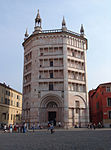Palazzo del Comune, Parma
Buildings and structures in ParmaCity and town halls in ItalyPalaces in Parma

The Palazzo del Comune (Palace of the Commune or Municipality) is a monumental building located in Piazza Garibaldi forming part of the civic center of Parma, region of Emilia Romagna, Italy. The building houses municipal offices. Across the Piazza Garibaldi (and the busy intersections of Stradas Mazzini, della Republica, Cavour and Luigi Carlo Farini) are a number of other prominent buildings including the Palazzi del Podesta and del Governatore, and the neoclassical Church of San Pietro Apostolo.
Excerpt from the Wikipedia article Palazzo del Comune, Parma (License: CC BY-SA 3.0, Authors, Images).Palazzo del Comune, Parma
Piazza Giuseppe Garibaldi, Parma Parma Centro
Geographical coordinates (GPS) Address External links Nearby Places Show on map
Geographical coordinates (GPS)
| Latitude | Longitude |
|---|---|
| N 44.8013 ° | E 10.32859 ° |
Address
Palazzo del Comune
Piazza Giuseppe Garibaldi
43121 Parma, Parma Centro
Emilia-Romagna, Italy
Open on Google Maps










